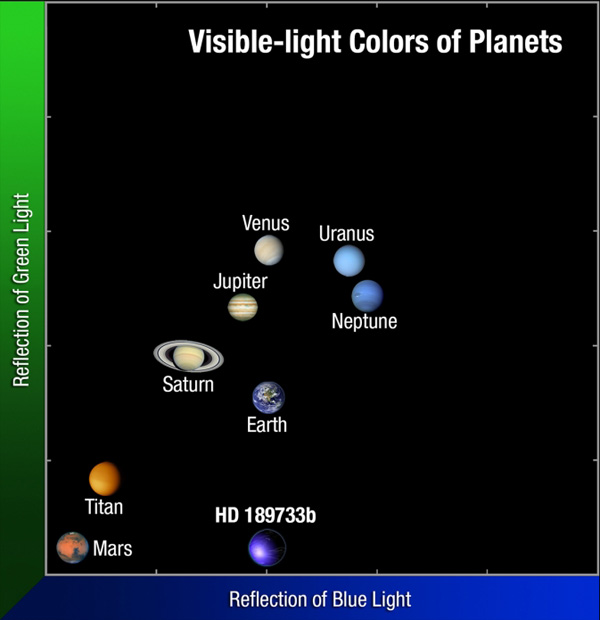A rendering of planet HD 189733b. Image via NASA
Blue moons are all the rage, but now it appears that there’s also a deep blue exoplanet out there beyond our solar system. Astronomers making visible-light observations with NASA’s Hubble space telescope have finally deduced the actual colour of a Jupiter-like planet known as HD 189733b.
First discovered in 2005, this planet orbits another yellow-orange star 63 light years away. And half of the planet’s face has a deep-blue hue!
The planet is one of the closest exoplanets that can be seen crossing the face of its star. It is only 4.6m kilometres (2.9 miles) from its parent star, so close that it is gravitationally locked. One side always faces the star and the other side is always dark.
Now scientists have used space telescope imaging technology to finally prove that this planet’s colour is blue – well, cobalt blue to be exact.
According to the space agency, Hubble’s Space Telescope Imaging Spectrograph measured changes in the colour of light from the planet before, during and after a pass behind its star.
It seems there was a small drop in light and a slight change in the colour of the light.
“We saw the light becoming less bright in the blue but not in the green or red. Light was missing in the blue but not in the red when it was hidden,” said research team member Frederic Pont, from University of Exeter in south-west England. “This means that the object that disappeared was blue.”
Deep blue something
Earlier observations of HD 189733b had suggested there was evidence for scattering of blue light on the planet.
This latest Hubble observation now confirms the deep-blue something is actually true.
NASA said today that if seen directly, this planet would look like a deep blue dot, similar to how the Earth’s colour looks as seen from space.
Alien-like, exotic planet
That is where the comparison ends, however. So don’t be rushing to pack your bags anytime soon if you think there’s a possibility that this blue planet can support human life.
You would need more than factor 50 sunscreen if you were to hang out on HD 189733b – that’s because daily temperatures reach 1,093°C (2,000°F) there. Then you would have to contend with showers of rain glass – sideways – in 6,437 km/h (4,500 mph) winds.
So where is this cobalt blue colour coming from? NASA believes the colour arises not from the reflection of a tropical ocean as it does on Earth, but instead a hazy, blow-torched atmosphere containing high clouds laced with silicate particles.
The astronomers involved in the project said silicates condensing in the heat could form very small drops of glass that scatter blue light more than red light.
As well as Hubble, other observatories have made intensive studies of HD 189733b since its discovery eight years ago. They believe its atmosphere to be “exotic”, NASA said.

This image compares the colours of planets in our solar system to exoplanet HD 189733b. The exoplanet’s deep blue colour appears to be produced by silicate droplets, which scatter blue light in its atmosphere. Image via NASA, ESA, and A. Feild (STScI)
‘Hot Jupiters’
It also seems that HD 189733b is among a bizarre class of planets called “hot Jupiters”, which orbit dangerously close to their parent stars.
NASA believes this latest Hubble observations will pave the way for new insights into the chemical composition and cloud structure of the entire class of hot Jupiters.
In 2007, the space agency’s Spitzer Space Telescope measured the infrared light, or heat, from the planet. This lead to one of the first temperature maps for an exoplanet.